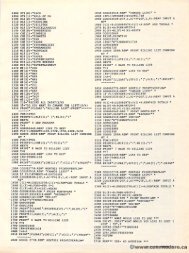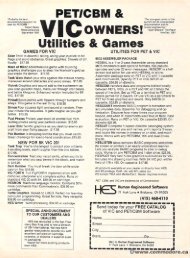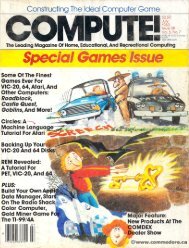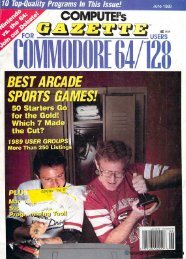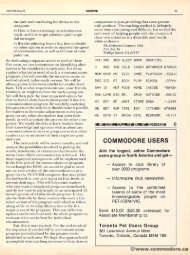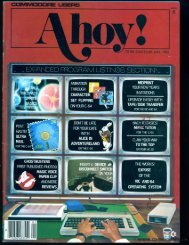Create successful ePaper yourself
Turn your PDF publications into a flip-book with our unique Google optimized e-Paper software.
156 COMPUTEI COMPUTE! May, 1Q82.lssue 1982. Issue 2-d 24<br />
changes it. Unless 1urphy has other pl ans, this<br />
changes it. Unless Murphy has other plans, this<br />
completes the tests.<br />
You .should be able to guess now what would<br />
happen if the PRINT 'Tstatemelll statement colllained contained cursor<br />
controls, forced quotes, commas, colons, a clear<br />
colllrols, forced quotes, commas, colons, a clear<br />
screen command, orr reverse lields fields (both at the<br />
beginning and the end of the space) within the<br />
quotes. All the info rmati on needed to answer the<br />
quotes. All the information needed to answer the<br />
questions is here and in the known facts off an<br />
ordinary I INPUT T statemenl. statement. I Iff you can't guess youu<br />
may walll want LO to try these things by repeating step II 11. .<br />
We don't need those answers for the simple applicalio<br />
cationn below, butt we may need lhem them forr other tasks.<br />
The Problem Solved<br />
Sin ce we noll' understand some of the PET's rules<br />
in this ibis game we can try a slightly more ambitious<br />
project: correctly picking up multifield records,<br />
our original illlenl. intent. A routine in lines 510-1060 1060 is<br />
used. By way of illustration, we use unformatted<br />
data from DATA lines. Two PRINT PRJ 'T statemellls<br />
statements<br />
fo rmat the data on the screen, avoiding garbage<br />
Since we now understand some of the PE'Fs rules<br />
format the data on the screen, avoiding garbage<br />
collection problems in thee string construction.<br />
(The strings are acwall actuallyy constructed in high me<br />
mory, but that does not contribute to the garbage.)<br />
mory, but that does not cOlllribute to the garbage.)<br />
PRJ NT C$ does not format the data, therefore a<br />
PRINT C$ does not format the data, therefore a<br />
null string will result on output/input, a slight<br />
complication if you u wantla to leave the e program<br />
intact. The shifted-space method is used. I leave it<br />
intacl. The shifted-space method is used. I leave il<br />
as an exercise to the reader to try null strings else<br />
as an exercise to the reader to try null strings else<br />
where on a line, while positioning ing subsequent<br />
fields correctly. An example is given in the two<br />
RF.M REM lines,<br />
es. which introduce illlroduce another variable.<br />
Admiuedly Admittedly these complications are unnecessary,<br />
unnecessary.<br />
they are included to make the task harder.<br />
As each part of a line is printed, prillled, the subroutine<br />
in 1010 I 0 places its image into an element of an array alTay<br />
AS(line,field A$(line,field). Note that in some applications you<br />
may not even have to go after each field. . You u may<br />
wish to pick up one, two, three, three. or all al) four fields in<br />
a single procedure by placing g GOSUB1010 I 0 I 0 where<br />
you u want it. I TThere are no new concepts in the code. TheT key variables ab are: arc:<br />
AS(I,j)<br />
A$(I,J)<br />
I<br />
j<br />
destination array<br />
record or screen line number<br />
field number, counted in subroutine from left<br />
to right<br />
cursor position before the fi eld is printed<br />
P(J-1) PU-I ) cursor position before the field is printed<br />
P(J) PU)<br />
cursor position after the field is printed<br />
Ww<br />
screen width varying with P(J) PU><br />
WS<br />
system screen width address where we adjust<br />
CP<br />
PS<br />
P<br />
screen size<br />
syste m address of cursor position on a line<br />
system address of cursor position on a line<br />
forces tabbing on a null string if such must<br />
exist. PS default is 1.<br />
flags when we're dealing with a null string.<br />
T he two P arrays could have been coded as si ngle<br />
The two P arrays could have been coded as single<br />
variables. They The)' are provided in array arra), form, for we<br />
may need those values for something else.<br />
may need those values for something else.<br />
When you run this demo program, you will<br />
see thallhe that the method works and is not all that complicated.<br />
Here, we have purposely set up certain<br />
roadblocks to see how far we can push the PET.<br />
There are more uses of screen input,just as<br />
there are more aspects to the method. Wejust<br />
scratched thee surface. But once we have thee basics<br />
we can go On on to bigger things.<br />
Screen input is userul useful ror for working with strings<br />
without th e usual penalty. I thank Jim Butterfield<br />
without the usual penalty. I thank Jim Buttcrfield<br />
for hinting at this in the POWER documentation<br />
and. more impo nalllly, fOI" ofrering a va luable<br />
and, more importantly, for offering a valuable<br />
warning abollt about lrollble trouble spots.<br />
10 REM SCREEN INPUT ELIZABETH I DEAL<br />
20 P1;POS(0)<br />
P1=POS(0)<br />
30 PRINT"ANYTHING";:GOSUB180<br />
40 PRINT"'":PRINT<br />
50 PRINTA$,LEN(A$)ASC(A$+CHR$(0»<br />
PRINTA$,LEN(A$)ASC(A$+CHR$(0))<br />
60 END<br />
180 P2;POS(0):P;0<br />
P2=POS(0):P=0<br />
19 1900 :REM IFP2;P1THENP;1<br />
IFP2=P1THENP=1<br />
2002 :REM IFP2;P1THENP;1:PRINTCHR$(1<br />
IFP2=PlTHENP=l:PRINTCHR$(1<br />
60); ;<br />
210 POKE198,P1<br />
220 POKE213,P2+P<br />
230 OPEN3,3:INPUT#3,A$:CLOSE3 : 240 POKE213,39<br />
250 POKE198,P2+P<br />
260 RETURN<br />
500<br />
:<br />
5100 W=39:WS=213:CP=198<br />
W;39:WS;213:CP;198<br />
520 R=3:NV=5:DIM R;3:NV;5: A$(R,NV),P(NV)<br />
,P(NV)<br />
530 BL$=" BL$;" ":PF$=CHR$(160):PS=1<br />
:PS=l<br />
540 FORI=1TOR:J=0:READ FORI;lTOR:J=0:READ A$,B,C$<br />
550 : REM PRINT"";:IFI=2THENPRINT"*<br />
ii " ,.<br />
560 : REM PS=2:GOSUB1010<br />
0 10<br />
570 PRINT LEFT$(A$+BL$,8); ; :GOSUB1010<br />
580 PRINT PF$+RIGHT$(BL$+STR$(B),6)<br />
(B) +" ";:GOSUB1010<br />
590 PRINT C$;:PS=1:GOSUB1010<br />
:PS;1:GOSUB1010<br />
600 PRINT:NEXTI:PRINT<br />
610 FORI=1TOR:FORJ=1TONV<br />
FORI;lTOR:FORJ=lTONV<br />
620 PRINTA$(I,J);<br />
630 NEXTJ:PRINT:NEXTI:PRINT:END<br />
: END<br />
640 DATA FIRST,12345,TEXT 1<br />
650 DATA SECOND,12rTEXT D,12,TEXT 11<br />
660 DATA THIRD,,,<br />
THIRD",<br />
1000 :<br />
1010 J ;J+1:P (J);POS(0) :P;0<br />
1010 J=J+1:P(J)=POS(0):P=0<br />
1020 IFP(J)=P(J-1)THENP=1:PRINT IFP(J);P(J-1)THENP;1:PRINT PF$;<br />
1030 P0KECP,P(J-l):P0KEWS,P(J)+P*PS<br />
1030 POKECP,P(J-1) :POKEWS,P(J)+P*PS<br />
1 040 P(J) ;P (J)+P*PS<br />
1040 P(J)=P(J)+P*PS<br />
10500PEN3,3:INPUT#3,A$(I,J):CLOSE3<br />
OPEN3,3:INPUT#3,A${I,J):CLOSE3<br />
1060 POKEWS,W:POKECP,P(J):RETURN ©<br />
1060 POKEWS,W:POKECP,P(J):RETURN ©





